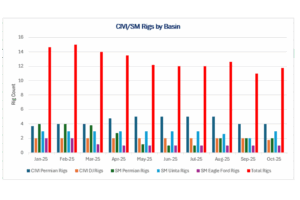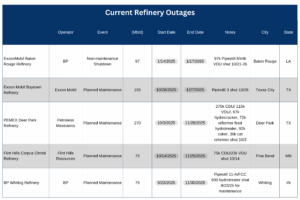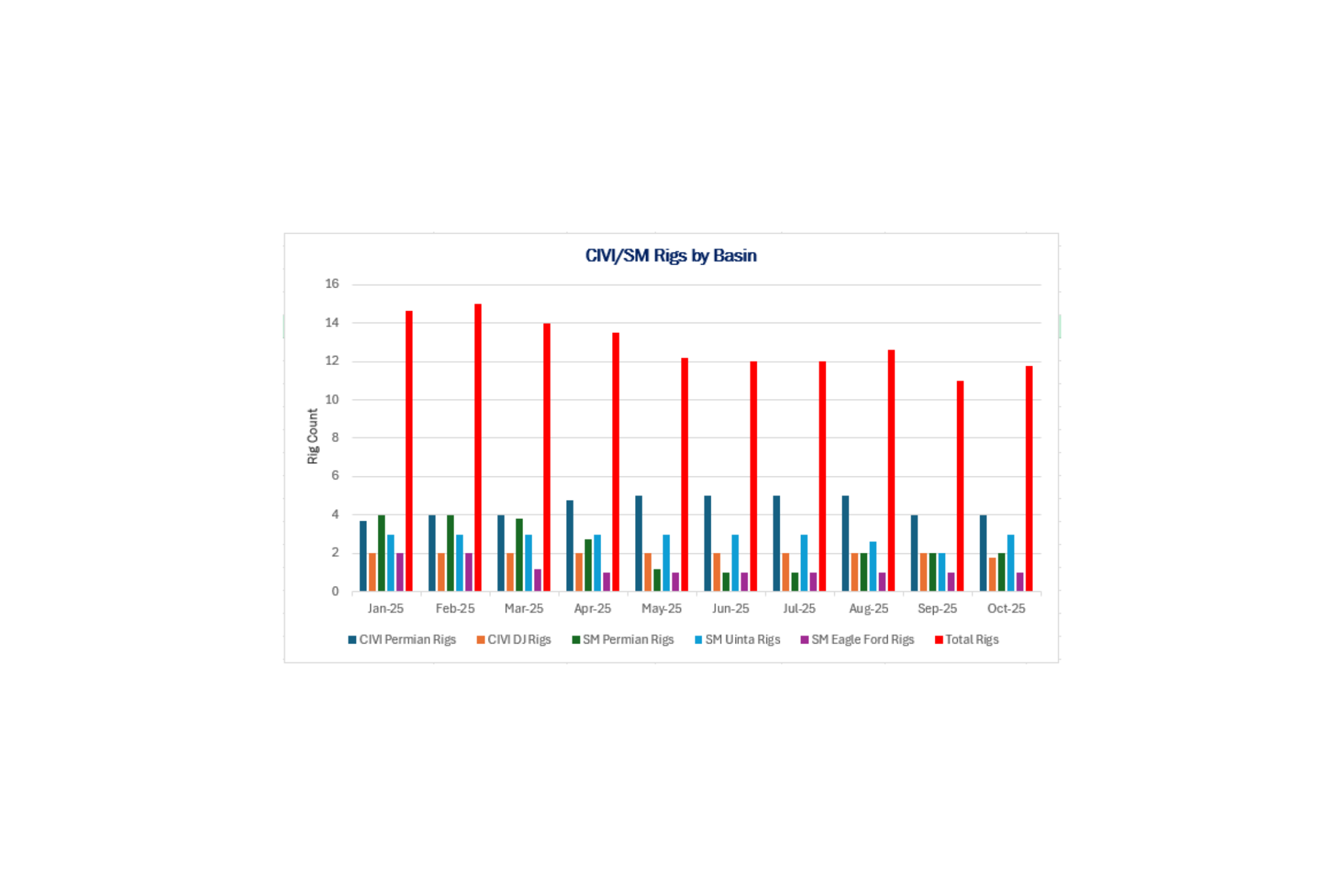Executive Summary:
Rigs: The total US rig count decreased during the week of Nov. 2 to 514
Infrastructure: SM Energy and Civitas Resources will merge under a $12.8B deal, creating a formidable E&P company in the Permian, Denver-Julesburg and Uinta basins.
Supply & Demand: The US natural gas pipeline sample, a proxy for change in oil production, decreased 1.3% W-o-W across all liquids-focused basins.
Rigs:
The total US rig count increased during the week of Nov. 2 to 514. Liquids-driven basins decreased 7 rigs W-o-W from 399 to 392.
- DJ (-1): BWAB Inc.
- Eagle Ford (-2): BP, Capital Star Oil & Gas
- Permian:
- Delaware (-3): Chevron, Permian Resources, Mewbourne Oil
- Midland (-2): ExxonMobil
- Powder River (+1): Anschutz

Infrastructure:
SM Energy (SM) and Civitas Resources (CIVI) will merge in a $12.8B deal including debt, creating a formidable E&P company in the Permian, Denver-Julesburg and Uinta basins.
The merger, announced Nov. 3, creates a firm with 823,000 net acres and 1,476 MMboe of estimated proved reserves, transforming SM into a top 10 independent producer. The companies together expect to generate $1.4B in free cash flow this year.
Recent upstream mergers have mostly resulted in reduced drilling as companies prioritize cost savings, and SM/CIVI will likely follow a similar path. SM said it expects to save $200-300MM annually through lower overhead and Opex.
In 2025, CIVI and SM have averaged 13 rigs across their operations in the Permian, Uinta, Eagle Ford and DJ basins. Their drilling programs have eased with lower oil prices, from an average of 14.6 rigs combined in 1Q25 to 12 rigs in 3Q25, according to allocations in East Daley Analytics’ Rig Activity Tracker (see figure below). SM and CIVI stated in a joint 3Q earnings call that production will slow down in 2026 if oil prices fall below their $65/bbl WTI goal for net leverage, as the merged company focuses on maximizing cash flow and reducing debt.

The producers’ wide reach gives them plenty of options to pare back. East Daley expects CIVI’s drilling program in the DJ to be particularly vulnerable to cuts. The Permian, the only basin where CIVI and SM have overlap, could also see reduced rigs from operational synergies.
East Daley clients can evaluate the midstream risks using the “Producer to System Analysis” dashboard in Energy Data Studio. Williams (WMB), Targa Resources (TRGP) and Kinder Morgan (KMI) have the largest G&P exposure to the merged producer. Of the three, TRGP has the largest combined exposure on its West Texas, Midland and Lucid systems. In the DJ Basin, WMB primarily services CIVI on its Discovery system and would be most vulnerable if the merged producer pulls back.
SM and CIVI expect to close the merger in 1Q26. The combined firm will keep the SM Energy name and ticker with headquarters in Denver, CO.


The Permian Basin at a Crossroads: Download Why This Pipeline Boom is Different
The Permian’s next big buildout is already taking shape — but this time, the drivers aren’t producers chasing oil. East Daley’s latest white paper reveals how gas demand from AI data centers, LNG exports, and utilities is rewriting the midstream playbook. Over 9 Bcf/d of new capacity and $12 billion in investments are reshaping flows, turning the Permian into a gas powerhouse even as rigs decline. Read Part II: Why This Pipeline Boom is Different
Supply and Demand
The US natural gas pipeline sample, a proxy for change in oil production, decreased 1.3% W-o-W across all liquids-focused basins.
The weekly decrease came mainly from the Gulf of America, down 12.3%. This decline coincided with increases in the Barnett (+3.4%), Eagle Ford (+1.2%) and Rockies (+1.2%) samples. The Permian sample decreased 1.7%, while the Anadarko declined by 1.2%. The Rockies and the Gulf of America have a high correlation between gas volumes and crude oil volumes, whereas the Permian and Eagle Ford basins correlation is less than 45%.

As of Nov. 17, there is currently ~670 Mb/d of refining capacity offline for planned maintenance, as refinery outages reach a low. Contributing to a large portion of the outages is the Pemex Deer Park Refinery which accounts for 270 Mb/d.
Vessel traffic monitored by EDA along the Gulf Coast increased significantly W-o-W. There were 30 vessels loaded for the week ending Nov. 22, peaking at levels not seen since the week ending Sept. 20.

Regulatory and Tariffs:
Presented by ARBO
Tariffs:
Gray Oak Pipeline, LLC: Certain available capacity discounts were increased.
Magellan Pipeline Company, L.P.: The tariffs were revised to add a new product and to update the product grade document to be consistent with ONEOK’s product grade documents.
The above information is provided by ARBO’s Oil Pipeline Tariff Monitor. For more information on regulatory proceedings or tariff rates, please contact please contact Corey Brill via email at [email protected] or phone at 202-505-5296. https://www.goarbo.com/


